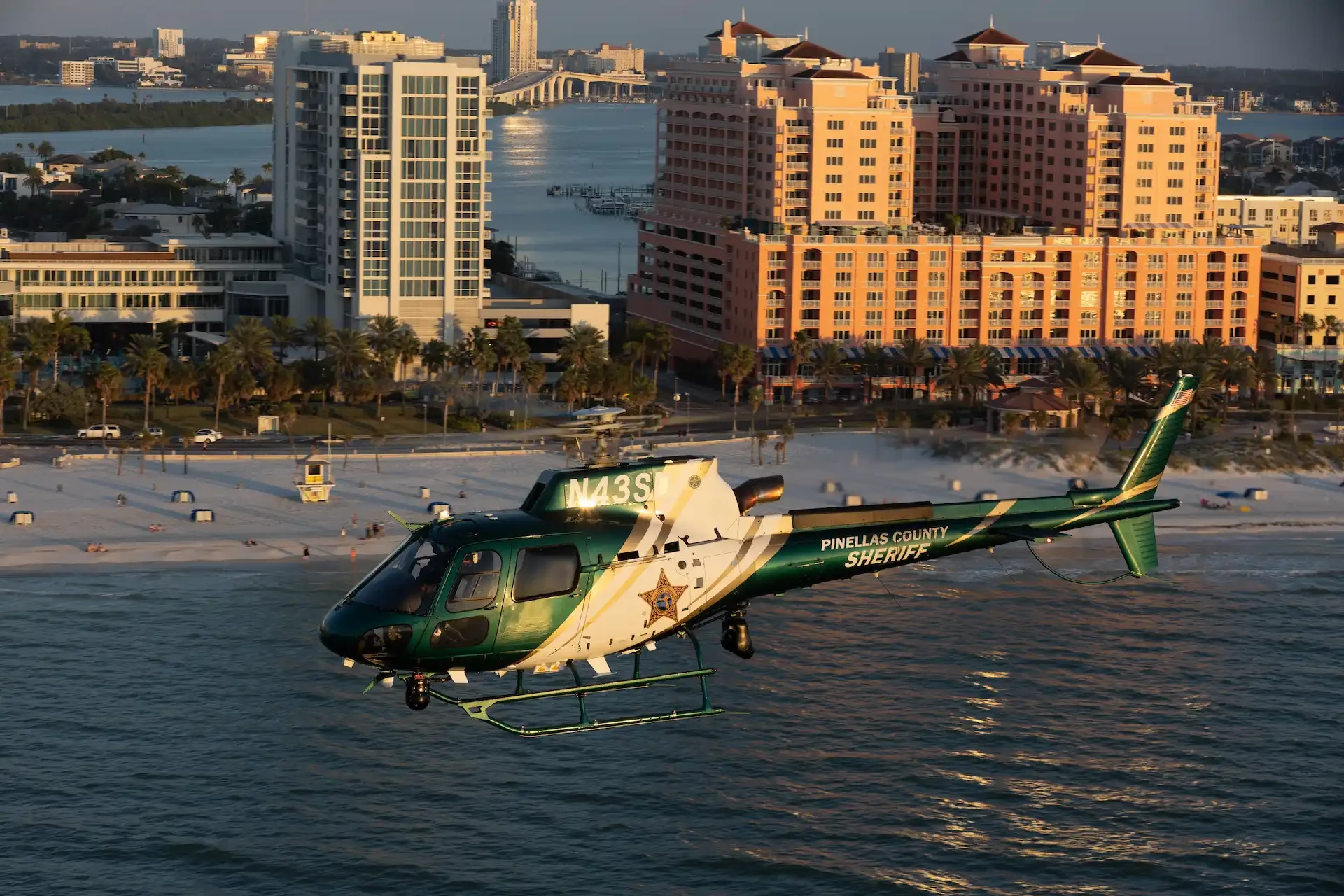Although the Pinellas County Sheriff’s Office has operated an aviation unit for some time, the last seven or eight years have seen cultural and operational reorganization within the unit and upgrading of its equipment, resulting in a dramatic increase in capabilities and performance, as Ned Dawson discovered.
Pinellas County on Florida’s west central coast is the second smallest county in the state by land area, at only 274 square miles, with a further 334 square miles of water. It is just 38 miles long and 15 miles wide at its broadest point, with 587 miles of coastline. It boasts, however, a population of around one million residents, a number dramatically increased by tourists, holidaymakers, snowbirds, and spring-breakers all enjoying the Florida paradise lifestyle of the peninsula’s many beaches, recreational areas and ocean. The Pinellas County Sheriff’s Office (PCSO) has responsibility for the entire county other than incorporated municipalities but does contract to provide law enforcement services to a dozen or more of those municipalities and is the only law enforcement agency in the county to operate an aerial law enforcement unit. Patrol functions are carried out with three A-Stars for twenty hours a day in two ten-hour shifts, starting at 09:00 and 19:00 respectively, and shutting down at 05:00, while a Cessna Grand Caravan fixed-wing bought a couple of years ago serves in the transport, surveillance, and ancillary roles.
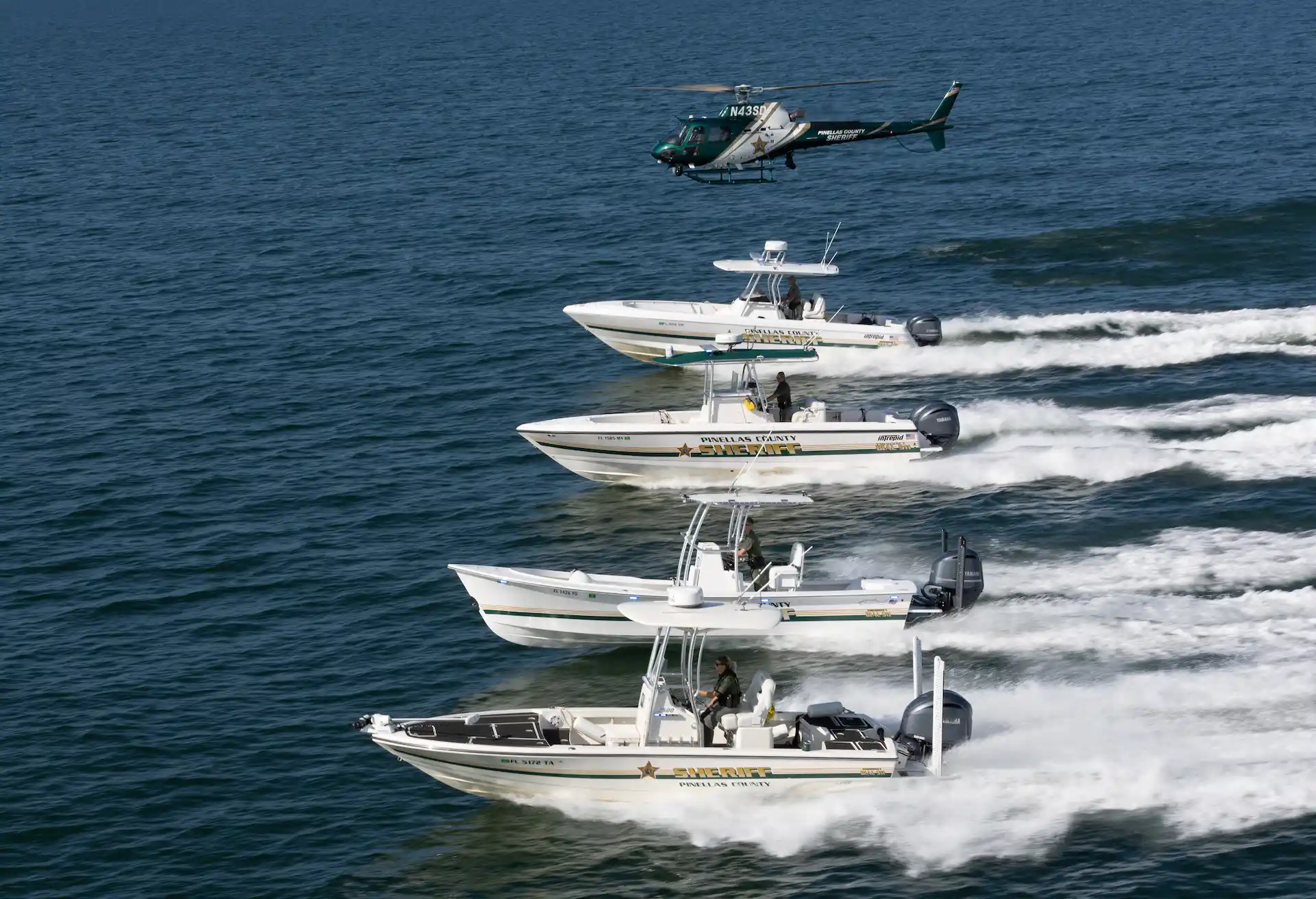
Aging Problems
Until approximately a decade ago, the PCSO air unit did not boast a particularly high ratio of apprehensions to callouts, with the result that fewer and fewer callouts were received from ground officers who therefore had limited expectations of the air unit’s capability. Part of the reason for this situation was the aging and somewhat dated equipment fitted to the unit’s AS350 helicopters, one of which was the first -B2 sold to law enforcement aviation in the US and thirty years old. Recognition within the Sheriff’s Office hierarchy that the technology was falling behind led to a push for modernization of the unit and a subsequent order for a new AS350-B2 to replace an aging Bell 206 Jetranger, but far greater-reaching initiatives were needed to achieve the desired improvements in aerial law enforcement operations.
The then sergeant overseeing the air unit had identified areas in equipment, tactics and techniques that offered room for dramatic improvement and modernization. As a result of his efforts, some new equipment and new, much more advanced mapping systems were purchased and the one new A-Star was ordered, but he then retired. Pivotal to the successful implementation of the necessary changes, therefore, was the introduction of some new, enthusiastic, forward-looking senior air unit personnel. Corporal Paul Rogers joined the unit in early 2016 with ten years in law enforcement, moving from a pilot’s position in another Florida law enforcement agency. He was particularly motivated to take the position because he was aware of the plans to progress the unit and enthusiastic to help take it to the next level. Rogers was followed just over a year later by Bryan Smith, who boasted a background of extensive law enforcement, flying and instructional experience. Rogers, although technically second in charge of the unit, carried the lion’s share of the unit’s organizational workload until Smith arrived to fill the Sergeant position as Chief Pilot. “Somehow I kept things above water, but I was really glad when he (Smith) came in because it’s a heck of a lot of work and not something I’d want to do long term,” Rogers admitted.
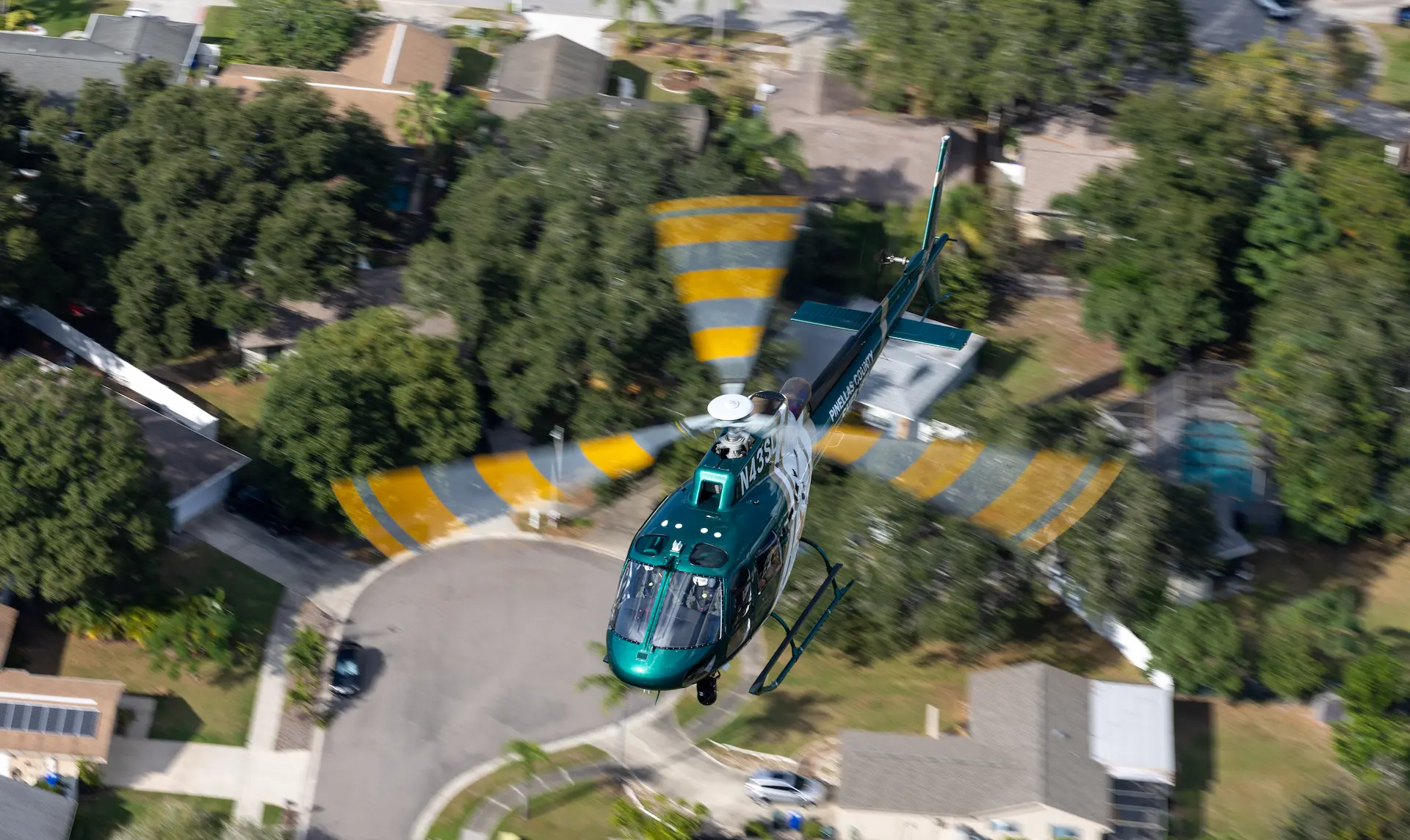
Change
The changes provided an opportunity to bring the unit into the current era of law enforcement aviation, as Smith outlined. “I think there are generational eras in our field and the current era is defined primarily by the shift from standard definition cameras without mapping systems, to the latest high-definition, multi-sensor systems that utilize fully integrated, advanced tactical mapping technology with downlink capability. There is a huge gap in capability between those two levels of technology,” he stated, explaining that at the time the modernization was instigated, the Sheriff’s office participated in a very active violent crimes taskforce, and the aerial surveillance technology was brought in as a key part of a plan to support that taskforce. The taskforce had been using air assets from several different agencies in the Tampa Bay area, depending on the specific area being worked, and the notable increase in capability that the later technology facilitated became a major catalyst for the upgrade program.
When the new -B2 arrived in 2016, the huge increase in operational capability and effectiveness of its new equipment was immediately apparent, but with only one third of the helicopter fleet so equipped, those improvements were only available approximately one third of the time. That situation then became the catalyst for obtaining a quote to upgrade the remaining two aircraft with the same new technology, with the resulting quote approved and signed off in just one week. Although the new equipment arrived in relatively short order, the modernization process has been a long-term project, as maximizing the new technology’s potential requires extensive training and operational experience. “When I got here, there were a couple of guys that were really good with it, but there was no established in-house training program for anything,” recalled Smith, who opined that it is fairly common within the industry that insufficient training is provided to optimally utilize available technology and resources, particularly in the TFO (Tactical Flight Officer) role. Alongside all the in-house and online training, the Pinellas pilots, however, all get sent to HeliStream in California for a week of additional externally supervised recurrency training and attend various industry seminars and training forums.
New Aircraft
More recently, the oldest of those two aircraft was replaced in 2022 with a brand-new Airbus H125, completed by Metro Aviation under Airbus’ oversight and fitted with the very latest versions of the mission equipment – including a 4th-generation MX10 that offers major capability and performance improvements over the 1st-generation units in the older aircraft – and with all three aircraft now boasting downlink capability provided by CNC Technologies. The new aircraft boasts larger displays, and its layout was designed by the PCSO aircrews, using their operational experience to establish the most practical and user-friendly setup for their needs. The H125’s Garmin autopilot offers one-touch auto-levelling, can shoot an approach and will hover in ground effect, while the upgrade to a Technisonic radio offers enhanced communication capability. An additional rear-seat TFO position now allows the deployment of three-person crews and these features add to a significant boost in power and performance to make the 125 a noticeable improvement over the earlier -B2 models. “I can get to the 135kt red-line for the camera and know that I could easily go over that if I didn’t stop it, whereas in the -B2s I could never get to that red-line,” Smith stated.
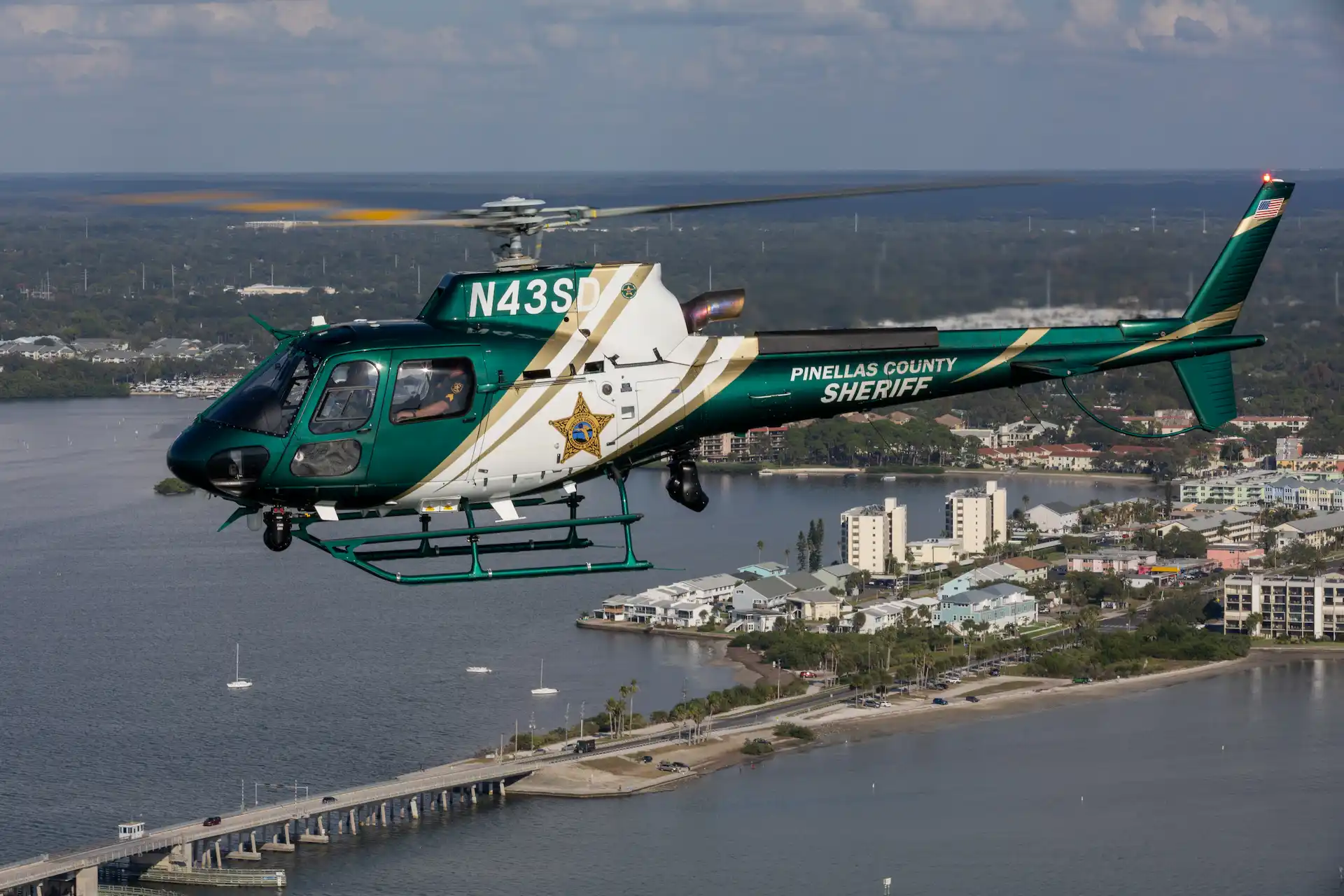
All Pinellas County Sheriff pilots are also TFOs, actively working in that role before ever flying as a pilot and Smith commented that officers entering the unit are assessed far more on their TFO skills and ability to manage technology, than on anything pilot related. “I think people outside aviation underestimate how much work it takes to do it right and do it well. It takes a new TFO a year or two doing it full-time before they’ve honed their skillset to a really professional level,” he stressed, and explained that once he arrived, work immediately began to establish a range of training programs and resources to cover all aspects of the unit’s operation. “Even with picking those personnel who were best fitted for the TFO role, it took a good three years before we were truly comfortable that they were all completely mission competent. Now though, they’re all at that level and we’re totally comfortable that any two of our personnel can go out and fly together totally effectively.”
Advanced Systems
All PCSO pilots are NVG qualified and IFR rated, or in the late stages of IFR training, and several will become flight instructors. Smith added that, now the more capable H125 is on the fleet, he intends to train pilots in more advanced techniques such as long-line and fast roping and a long-term goal is to replace the two remaining AS350s with new H125s. “During a hurricane, the Coast Guard relocated all of its aircraft to locations out of state, so if a storm comes through here, we’ll be the only resource to assist on the peninsula and HEC work (human external cargo) will be the only viable rescue method in many situations.” It was pointed out that the high cost, heavy maintenance demand and weight penalty of a hoist make HEC the best choice for rescue work in the light single-engine H125 and A-Stars for PCSO since usually there are a dozen USCG hoist equipped aircraft available from the local air station (unless relocated for a hurricane). During Spring Break and the summer, daytime water rescues are a relatively frequent occurrence, and the helicopters will search for and locate persons in distress and guide other rescue services to the scene, while for night rescues, the onboard thermal camera and spotlight are obviously indispensable aids. Although the helicopters cannot currently rescue people in the water, in cases of dire urgency they can drop ‘rescue sticks’, auto-inflating rescue aids for emergency flotation.
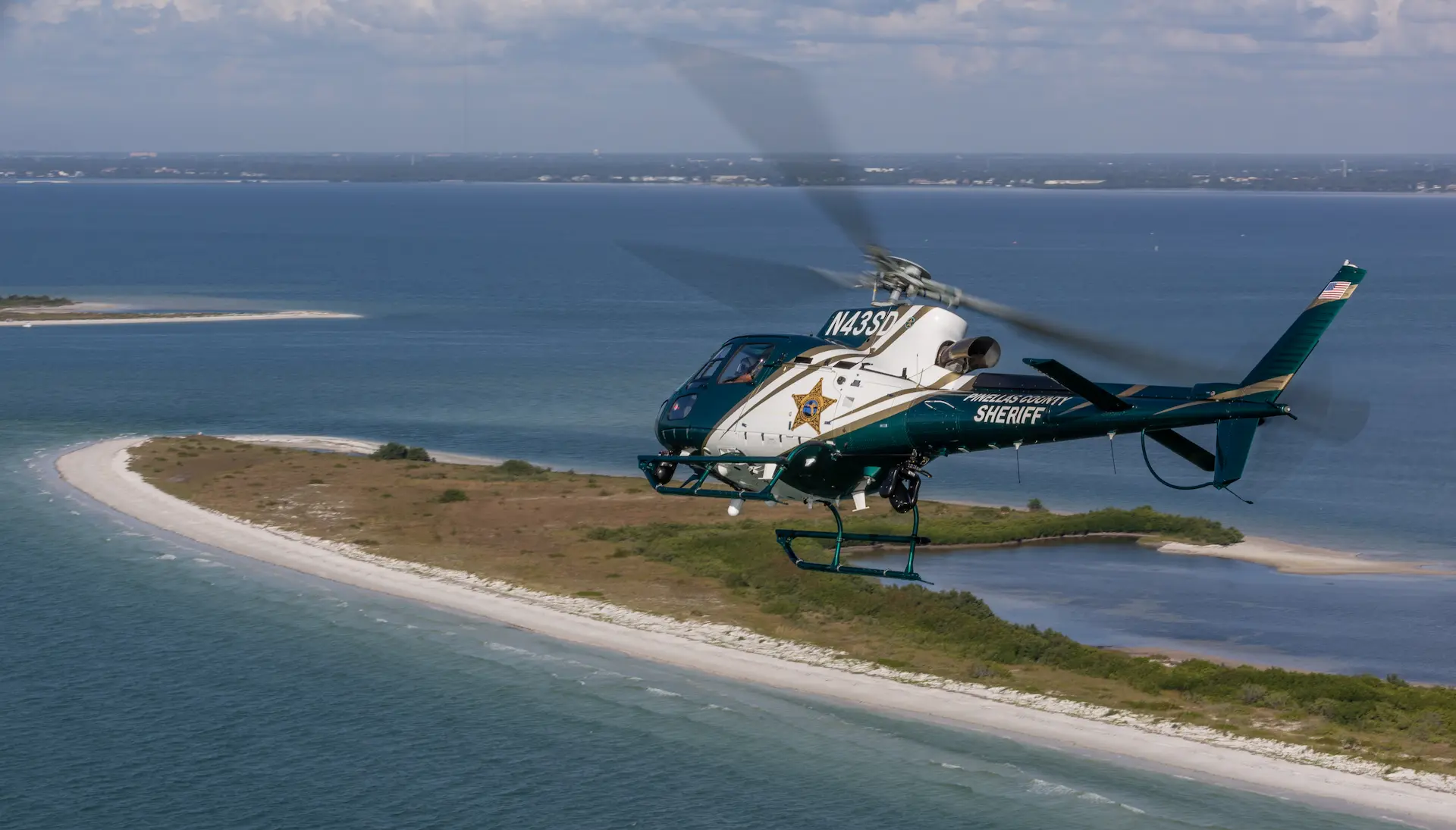
A key component of the new equipment is the L3 Harris WESCAM MX-10 camera turret fitted to the patrol helicopters. The MX-10 can be operated effectively on just its programmed automatic settings and still be vastly more effective than the older generation FLIR 8500 camera system it replaced, but Smith pointed out that its extensive range of adjustments and manual control options make the MX-10 capable of substantially greater performance in the hands of a highly skilled operator. Wescam does provide MX-10 customers with a comprehensive training package that goes into the finer technical points of camera operation and mission optimization, so a great deal of the PCSO training is therefore focused on getting the most out of the MX-10 and its integrated tactical mapping system. One pilot advised that the camera performance can be so precisely fine-tuned that he has been able to see shadows on the sidewalk while in infrared mode, from an altitude of 1,500ft, while someone else reported locating an absconding offender after a forty-minute search, just from a slight temperature differential in the metal exterior of a dumpster in which he was hiding.
The quality and effectiveness of the PCSO training has been proven during visits to other agencies, with Rogers noting that he has been able to advise those operators of MX-10 features and capabilities of which they were completely unaware, despite their having used the system significantly longer than the PCSO. He believes that the unit is now using virtually all the MX-10’s capabilities in the missions the air unit conducts but noted that the system still offers many un-utilized functions and features that simply don’t apply to the PCSO’s mission-set. One feature that has proved to be a real benefit is the system’s fire-mapping function. Although not used for fire mapping, it has been extremely useful in mapping and reporting the ‘red-tides’, toxic algae blooms that have a detrimental effect on an area that enjoys significant tourism. Wayne Zelinsky related how the combination of the HD camera and integrated aero-computer mapping enabled him to follow a pursuit while still out of camera range, directing the camera with the mouse on the map to the reported location so that when arriving on scene, the camera is already dialed in and pointed at the target vehicle. “That’s something I couldn’t have done as a first year TFO, but the regular training and experience with the system makes it doable. That type of work and thought process is a total culture change from what it was here seven or eight years ago.”
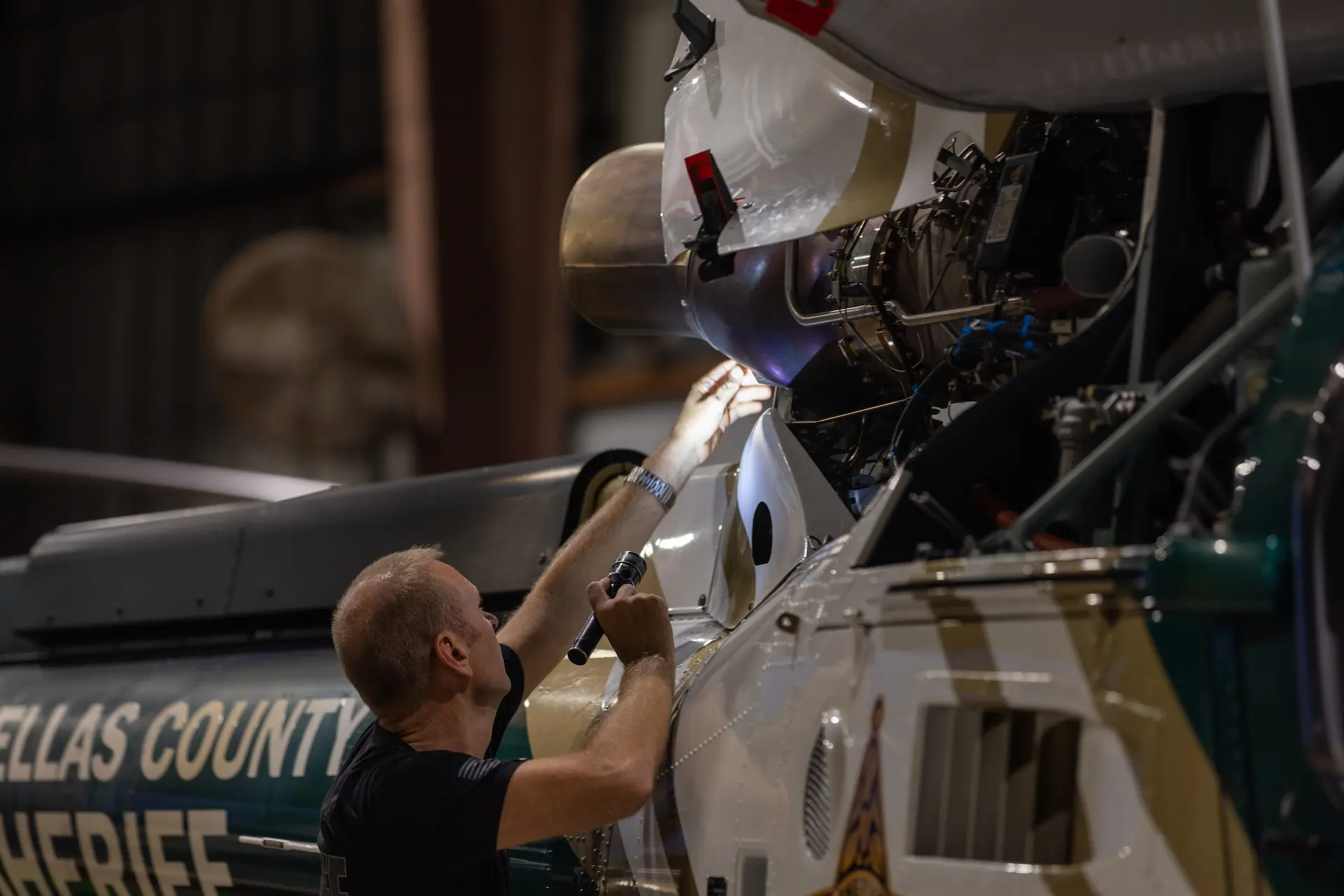
Growing Pains
The success of the modernization has not been without growing pains, however, particularly for the maintenance personnel, under the director of maintenance, Brian Egnatuk. As the vastly improved efficiency and effectiveness of the air unit has become proven and known throughout the Sheriff’s office, the number of calls for air support has increased dramatically. “Because they know the chance of success is so high if we’re on a call with them, everybody on the street now calls us; often even before they’re on scene,” Rogers advised. “The inevitable result is a significant increase in flight hours, which means much more frequent maintenance. We used to do one 600-hour check a year and now we’re doing three, and they’re each a month long. The maintenance personnel deserve a lot of credit because if we didn’t have the aircraft available, we couldn’t be as successful as we now are.” He opined that the personnel in the Part 145-approved maintenance operation are the most highly regarded part of the unit, and that it is unheard of to hear any negative opinion or feedback about their support or service. “When they work on something, their goal is not just to get it within limits, but to get it as close to perfect as is humanly possible and that is why the aircraft are so incredibly smooth to fly and so trouble free in operation. Another maintainer would be nice though, because they are always busy every day, from the time they arrive until they leave at night.” Although the missions flown all fall under the public use category, flight operations are all conducted at least to Part 91 and usually to full Part 135 standards, while maintenance is carried out to Part 145 requirements and follows all Airbus manufacturer guidelines and recommendations.
A fortunate and coincidental recent change within the unit has been an intake of new, younger personnel as natural staff movement and attrition has seen several of the older crew moving on. The younger members have grown up with computers and gaming and are much more at ease with the high-level technology now utilized in the unit’s aircraft. The unit is slated for a flight crew complement of twelve members, with three full-time maintenance personnel but after a pilot left to take on a different role, there have been challenges filling that final pilot slot. Efforts were made to recruit from outside the Sheriff’s office but that did not prove easy. “We specifically needed a fixed-wing pilot because only two of us meet the criteria to fly the Cessna now. We wanted a minimum of 1,000hrs flight time and applicants also had to have law enforcement experience, because we fly in both seats and everything we do in this unit is focused on the end goal of putting the TFO in the right position to do meaningful work.” Smith pointed out that that many agencies operate with a division between the pilot and TFO roles but PCSO’s philosophy is the opposite. “By starting everybody in the left seat they get comfortable operating the camera and systems, so by the time they start sitting in the right seat they know exactly how the TFO will want the aircraft positioned. Another advantage is that experienced crews comprise two command pilots who will alternate between the TFO and pilot position. They both therefore remain current and qualified on both the aircraft and the camera systems, and never get bored.”
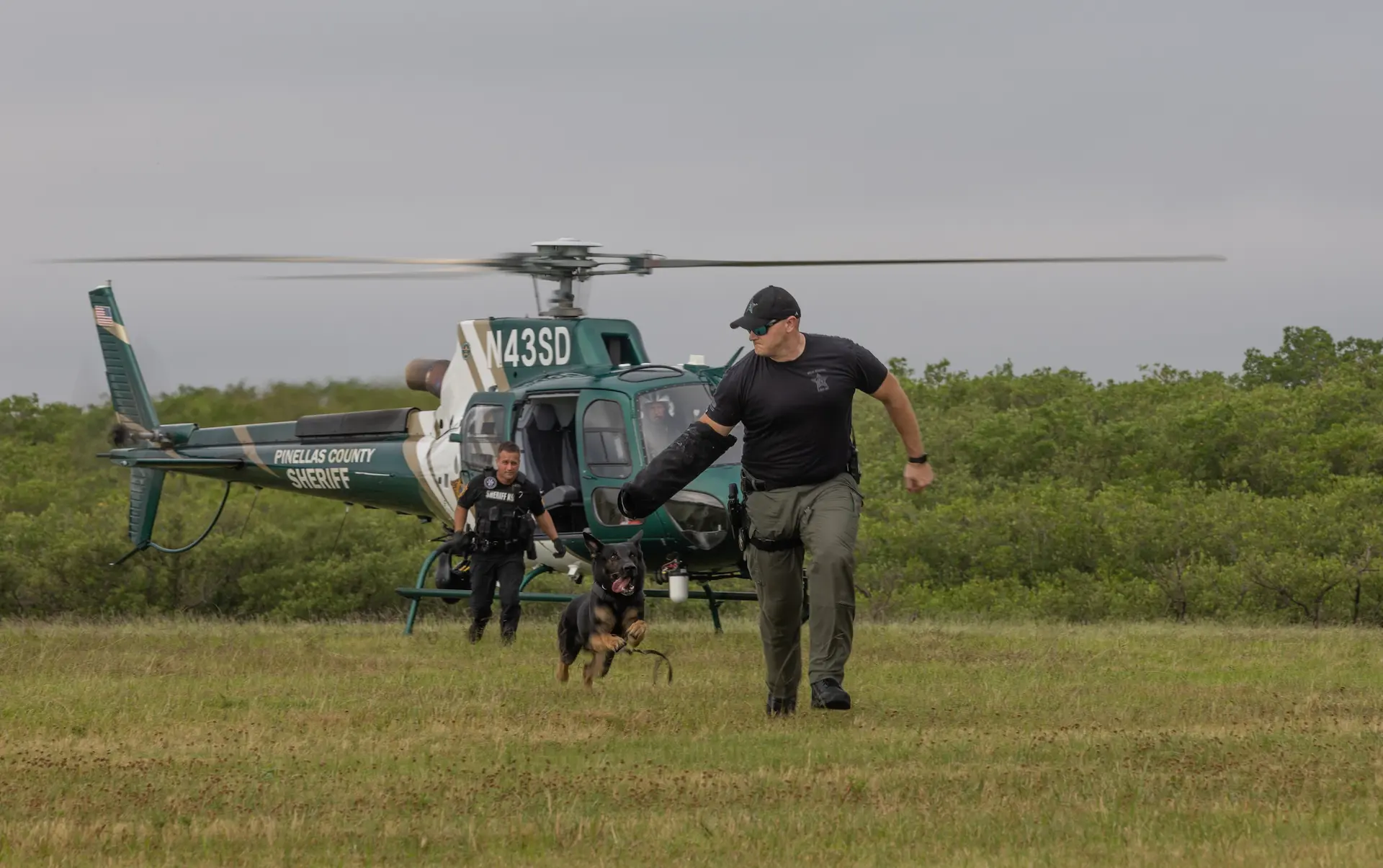
The Old Man
Zelinsky calls himself the ‘old man of the unit’, with 25 years in law enforcement and a spot on the unit since 2018, logging about 1,100hrs in the last three years. He was the first pilot to be trained in-house on the unit’s A-Stars, as prior appointees were all trained to CPL(H) by an external training organization before transitioning to the A-Star on the unit. “I started on the camera for about a year and a half, and began pilot training after a year,” he recalled. “Like Paul said, I’ve never loved a job before, but I love this job! We only get called to serious occurrences, pursuits, stolen cars, shootings and so on. It’s an adrenaline rush because we’re always going to something interesting. It can be immensely satisfying and rewarding too, like at two in the morning when we found an eighty-five-year-old Alzheimer’s patient who fell in the woods, and would have been dead if we hadn’t found him. I like that we’re always getting better and always adding to what we do.”
Rogers is still incredibly enthusiastic about his job on the unit, commenting, “You know the saying that when you find a job you love, you never work another day in your life? Well, that’s true for me here. It’s just fun and you never know what’s going to happen as the day unfolds. It might be a water rescue, a high-speed pursuit or just a transport mission, but it’s always different and I can’t stand doing the same routine every day. With the unit progressing as it is, we’re always pushing forward so there are always new things on the horizon and new missions to look forward to.” When Smith moved to the Pinellas air unit five years ago, it was because had he remained where he was, there was no likelihood of him obtaining a chief pilot position; something he wanted to achieve before his career ended. He added that he considered the most rewarding aspect of law enforcement to be flying on an incident brought to a successful conclusion, when that would not have been possible without the support of the air asset.
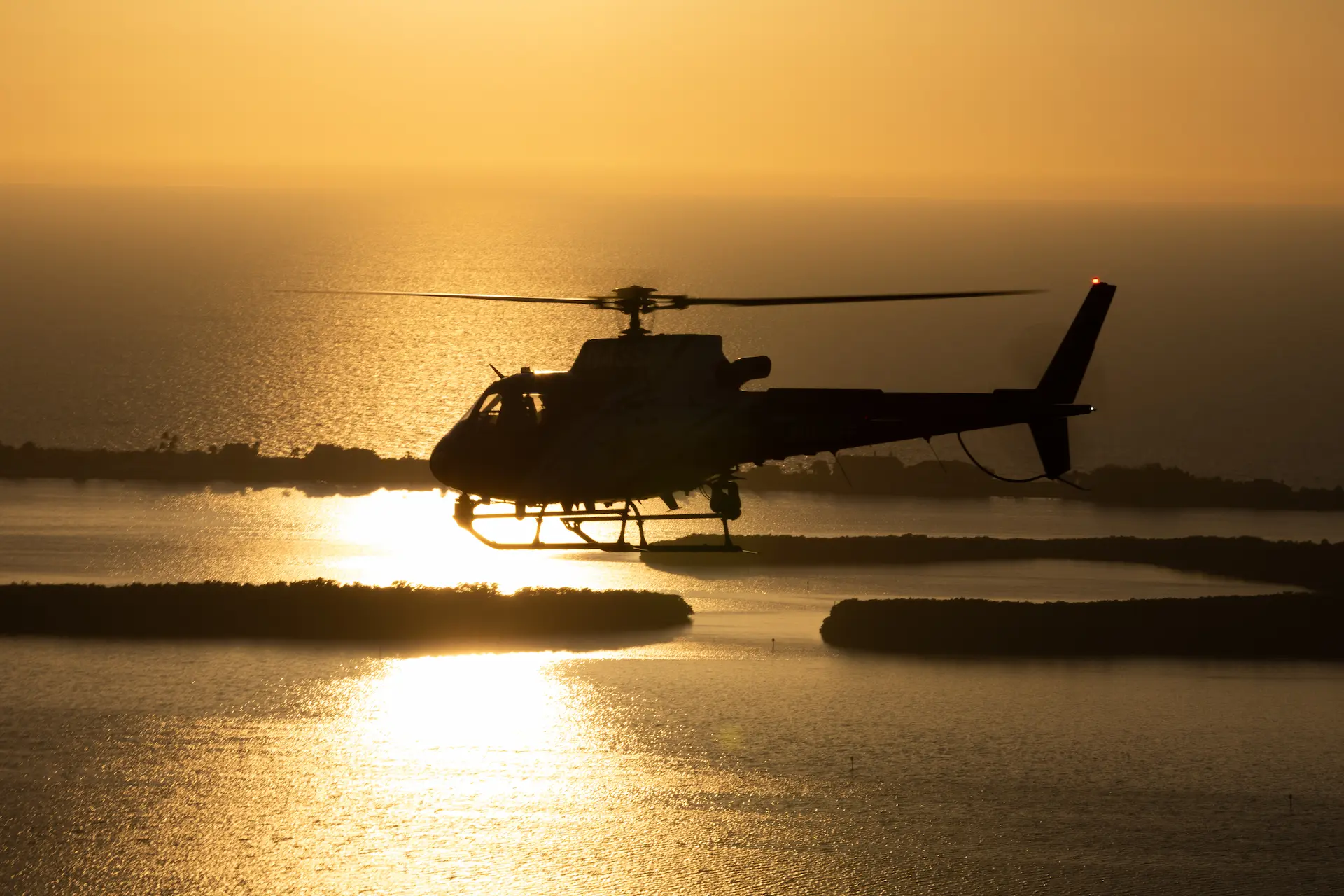
Progress to the Best
“This unit is the best staffed, the best equipped and the most effective that it’s been since I started here five years ago. With what we have here now, this unit is the best kept secret and the best place to be in law enforcement aviation. I came here because I wanted a chance to do something significant with it and they indicated to me that they wanted to finish moving the operational side of this unit to the next level.” When Smith arrived at the unit there was no established safety, pilot training or TFO training programs, and no NVG usage but he did find motivated people that wanted to build a professional unit, with a culture of enthusiasm to progress the unit forwards. “The pilots here in general did not have a lot of flight time, so there was a lot of work involved in building experience and getting everybody NVG-qualified, instrument rated and trained in techniques and tactics. Now though, I’ve seen our guys pick up a fleeing car up to seven miles away. That took two or three years of steady, hard work but now, no matter what time it is, they’re running out to the helicopter when a call comes in because they all want to fly and to give the best support they can. There are no other public safety aircraft in the county so when anyone in the county needs air support, this is the only game in town. I’m not joking when I say that I want this to be the best air unit in the world, and upper management has been unstinting in their support for all the changes needed to progress towards that goal,” he concluded.
 HOME
HOME


